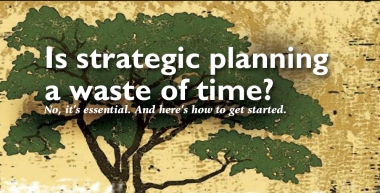
It’s become a cliché: The institutional plans, over which so many toiled for so long, now filed away or put on a top shelf. In the stereotype, such plans have no impact on what the organization actually does from day to day or even from year to year.
But this image doesn’t reflect strategic planning’s potential usefulness. In fact, only through prayerful reflection, careful analysis of internal and external factors, hard-nosed financial planning, and careful strategizing can an institution discern where to put its energy and its resources.
This isn’t a once-and-done process. Rather, if there is appropriate participation by the board, the administration, the faculty, and others, strategic planning is almost constant — an essential guide to an institution’s future, but one that recalibrates just as a computerized navigation system does when you zip off the highway to avoid congestion or take advantage of a shortcut.
Requirements by the Association of Theological Schools and other accrediting agencies mean that no school can avoid strategic planning. But wise planning practices are more than a requirement — they ensure that all parts of a complex institution are aligned and moving ahead.
Benefits
What is strategic planning? In the general business literature you get a variety of definitions, but I like to think of strategic planning as an interactive process in which a school’s leadership formulates the optimal way to achieve a desired future. There are always many options for achieving a stated purpose for being, but a strategic plan declares this: Of all the possible ways to fulfill our vision, for the next number of years we have chosen a specific course of action — a pathway to get from here to there.
If you accept this definition, you can achieve several benefits by establishing a strategic planning process.
- Strategic planning provides a season of focused energies on a school’s tactical choices. That is, it causes the key constituencies to break away from the urgency of short-term deadlines and activities to participate in a shared, rigorous imagining of the future.
- Strategic planning builds stronger community by assembling people who care about a school — faculty, administrators, board members, and others — for a common task.
- Strategic planning charts a future course of action that aligns the resources and motivations towards goals that are achievable with coordinated work and God’s help.
- Strategic planning offers hope for the achievement of a preferred future that fulfills mission with economic vitality.
Drivers
It’s the president or chief executive officer who stewards the relationships and authority structures that will ultimately champion and approve a strategic plan.
But it’s important for the governing board to legitimize the president’s strategic planning efforts — usually by reviewing and approving a calendar of events and milestones. Also, during the strategic planning period, the governing board should receive progress reports and engage with the president at major milestone dates. One of the first important decisions that the president makes is to choose how best to organize the process. There are two competing factors — administrative efficiency versus institutional involvement. The efficiency factor leads to an end result that meets certain timeframe requirements. The involvement factor leads to the all-important buy-in. The wise president keeps these two important factors in creative tension.
At many schools, the president delegates much of the strategic planning efforts to a member of his or her leadership team. But whoever is involved in driving the process, that person must keep the president engaged at every important planning meeting and at every important decision point. The president must also communicate to the entire campus an enthusiasm for the process and highlight the collaborative, inclusive approach.
Much of the strategic planning work is done in special planning sessions. In these sessions, the president’s leadership team or cabinet carries the primary responsibility to synthesize data and formulate the plan. There are great benefits to involving faculty, administrators, members of the governing board, staff, students, and alumni in the process. Usually, this is accomplished by appointing a credible planning task force composed of key representatives.
Some schools have found the establishment of a time-limited strategic planning council to be a useful mechanism to move the planning process through milestone dates while taking advantage of wider institutional involvement. The strategic planning council’s membership often spans the board, faculty, and administration. It is important that the strategic planning council have a written charter that is shared broadly with constituent groups. The charter should include a purpose statement, a list of members, a schedule of meetings, a description of member responsibilities, and an explanation of the strategic planning methodology.
Critical steps
There are five steps in a comprehensive strategic planning process. These steps are not purely sequential, but may be best thought of as interrelated activities. Having said that, there is a logical progression in strategic planning that moves from reflection to analysis and from there to strategy formulation, resource alignment, and implementation.

- Reflection. The initial activity should be a special season of time in an institution’s life for disciplined reflection. A school carries this out in ways consistent with their theological heritage. It can include corporate and individual prayer, a review of the school’s rich history, the retelling of stories, and a naming of some of its current “bright spots.” Even at this early stage, a new vision may be in the heart of the school’s leader.
- Internal and external analysis. The next activity typically includes a time of objective analysis of the school’s internal strengths and weaknesses and its external opportunities and threats. Formal assessment can create a tremendous amount of useful information for this step in the process.
This analytical and research work is a great place to build future buy-in by broadening the involvement of faculty and staff in areas of their expertise. For example, some schools identify all of the internal and external categories to be analyzed and appoint task forces (or offer other opportunities for participation) that include faculty, administrators, and staff who have the needed competencies.
The section below lists sample categories for an external and internal “environmental scan.”
- Vision and strategy. The heart of the strategic planning process is the strategy formulation phase. It includes taking all the inputs — both the reflective and the analytical inputs — along with a new vision statement and then charting the best course of action to achieve the school’s mission and vision. This work requires testing alternatives and demands that participants resist the temptation to go with the first ideas that come to mind. It normally includes a limited number of goals and initiatives.
- Resource alignment. This phase of work starts with a clear understanding of the school’s financial strength, the integration of the strategic goals with the development of a branding and marketing position, a sustainable economic model, a case statement for donor support, and an assessment of the school’s capacity to achieve the desired strategic directions and goals. Inherent in this resource alignment work is the decision making around the adequacy of resources allocated for current students versus those developed for future students.
- Implementation and adaptation. The final activity is the critically important work of design and implementation. This work encompasses everything from the design of the organization to the development of detailed annual goals, comprehensive campaign considerations, operating and capital budgets, standards and information gathering, and assessment systems. The implementation of strategic plans requires an adaptive mind set. New opportunities and threats will emerge and require mid-course adjustments.
Of course, the governing board should keep the strategic plan implementation as a part of its board meeting agendas, asking the president to explain progress and monitoring whether major initiatives are being launched successfully. Effective governing boards work in partnership with the president to evaluate how resource constraints and other obstacles can be addressed.
Common mistakes
Christian colleges, universities, and seminaries may not put enough time into discerning God’s agenda for their institutions. Instead, there is a temptation to launch into strategic planning using only good business principles and best practices.
But in failing to acknowledge that the school’s mission is connected to advancing God’s kingdom, a school’s planning efforts can lack a God-centered focus. Psalm 127:1-2 suggests that if a Christian institution makes the mistake of leaving God out of its planning, it will labor in vain. In essence, schools need to go about the hard work of strategic planning while counting on God to guide them. In the words of Proverbs 16:9, we “devise our way,” but the Lord “directs our steps.”
Another mistake relates to whether or not stakeholders are meaningfully engaged in the planning process. Too much involvement by too many persons can doom a planning process into an accommodation of divergent opinions. That process can dilute the focus and energy of a clear and compelling vision statement — the vision that any school depends on its top leadership to deliver. Too little involvement can result in the perception of a top-down planning initiative that never gains the enthusiastic buy-in of the stakeholders and constituents of the school. That means a lost opportunity to gather the momentum of the governing board, faculty, staff, alumni, and donors. The president and the president’s leadership team must find the right mix, managing this natural tension between efficiency and involvement.
A third and related challenge is maintaining effective, ongoing communications with all of the key members of the school’s community throughout the strategic planning process. A fourth mistake is what I call “stand-alone strategic plans.” These kinds of plans deliver an energizing vision statement along with exciting goals and initiatives. But such stand-alone plans lack something very important — goals, milestones, and phased plans that are aligned with resource capabilities and requirements. That lack of integration is likely to lead to a strategic plan that is more akin to a dream than a purposeful master plan that can be achieved.
An integrated process
An integrated strategic plan includes the assimilation of activities related to such things as assessment, financial planning, marketing, and donor development. For example, integrated strategic planning uses assessment data for continuous improvements at both the academic and broader institutional levels. It includes the alignment of financial and physical resources with the school’s mission, vision, goals, and initiatives.
A well-developed strategic plan serves as the springboard for a compelling case statement for donor support, which inevitably leads to a comprehensive fundraising campaign. Strategic plans also challenge assumptions about the school’s marketing position and branding decisions. Finally, a strategic plan leads to a comprehensive, compatible longer-range financial plan that includes assumptions about operations, endowment, facilities, and long-term debt decisions.
The result
Clearly, this process does produce a document that has several components. It can be helpful to think about it as an outline:
- A preamble that includes a brief description of the planning process and governing actions that were taken to legitimize the process. This preamble to the plan may also include a brief history of the school’s previous planning efforts and the results achieved by those efforts.
- A summary of the analysis and a ranking of the major strategic issues. This summary is often based on the analysis of the school’s strengths, weaknesses, opportunities, and threats — the “SWOT analysis.” It’s helpful to include the actual SWOT analysis as an appendix.
- A new approved vision statement and key goals.
- Four to six key initiatives that are needed to achieve the vision and goals. Every major initiative that relates to new revenue streams or the growth of existing revenue streams should include a five-year business plan.
- Action plans needed for implementation, along with performance benchmarks.
- A five-year comprehensive financial plan that includes information related to operations, endowment, facilities, and long-term debt. This plan should include operating assumptions related to the school’s major revenue streams and the personnel and other operating-related resources necessary to achieve the mission with excellence. This part of the plan is also best shown as an appendix to the document.
A warning: This kind of document can become a binder that gathers dust if it is too wordy. It takes more work to boil down the essentials of weeks and weeks of planning work into an actionable document than it does to deliver a lengthy comprehensive document. Ideally, the heart of the planning document — the vision statement, goals, initiatives, action plans, and benchmarks — should fit on five pages or less.
How to begin
Start by reading some of the good literature on the subject. And talk to a few people who have some experience in strategic planning.
But most of all, make a commitment to begin it. The board and president should encourage one another to understand the value of effective strategic planning, and then the board should ask the president to design a process, set some milestone dates, organize to get the work done, announce it to institutional stakeholders, and dive in!
Finally, don’t make the mistake of biting off more than you can chew. Remember the 80/20 rule: You will probably gain 80 percent of the strategic planning benefits by doing 20 percent of the planning activities in each of the important categories.
Resources for further help
Of course, there are always good books to read. Here are a few favorites:
- Strategy Safari: A Guided Tour Through the Wilds of Strategic Management, by Henry Mintzberg, Bruce Ahlstrand, and Joseph Lampel (Free Press, 2005, $18).
- Small College Guide to Financial Health: Weathering Turbulent Times, by Michael K. Townsley (National Association of College and University Business Officers, 2009, $72).
- Collaborative Strategic Planning in Higher Education, by Patrick Sanaghan (National Association of College and University Business Officers, 2009, $56).
- Strategic Financial Analysis for Higher Education, by Ron Salluzzo, Fred Prager, Lou Mezzina, Chris Cowen, and Phil Tahey (7th ed., Praeger, Sealy & Co., 2010, $87).
The National Association of College and University Business Officers (NACUBO) also offers seminars and other resources.
Sample categories for external and internal analysis
The external environment
It is useful to understand the opportunities and threats in the external environment. The purpose of this exercise is to identify a critical few issues that may have a significant effect on the school’s strategic plan. The following categories of analysis are recommended:
- Peer comparison. How does your school compare to your current peer group? How does it compare to a group of schools that you aspire to join?
- Religious worldview. Is your school addressing the needs of the churches that you serve? How are these needs changing? In what ways are your students being prepared for the theological environment that they will face after graduation? What other spiritual and religious trends does your curricular and co-curricular planning need to address?
- Global developments. What changes around the world might have an effect on your school’s mission as it relates to foreign students, global teaching possibilities, and preparing students to face an increasingly interconnected world?
- Higher education trends. How are the rapid changes in higher education affecting accreditation standards and the cost of education? How are the latest practices in teaching and learning being implemented at your school? How is your school incorporating new opportunities for educational innovation and increasing expectations for accessibility?
- Economic factors. How is the regional or national economy affecting your school’s enrollment, degree offerings, and the ability and capacity of donors to give?
- Technology. How can new technologies improve administrative processes and academic programming? How do you determine the “return on investment” for new technology?
- Demographic research. Is the size of the pool of your potential student body growing or shrinking? In what ways are the characteristics of your pool of potential students changing over time? What market niches are developing? How will the anticipated transfer of wealth between generations affect your school?
- Other categories. Depending on your school’s sensitivity to other environmental factors, you may want to include other categories of study like politics, federal and local tax trends, and social, cultural and intellectual trends.
The internal environment
It is equally useful to identify the strategic issues that emerge from an analysis of a school’s internal strengths and weaknesses. The following subcategories of work are recommended:
- Leadership capacity. What are your school’s strengths or gaps in leadership related to administrative, academic, and board work?
- Students. What kinds of students are currently drawn to your school? You need to know this to determine the ideal shape of future incoming classes and to match academic and student life resources to those student populations.
- Alumni and donors. How do alumni and donors perceive your school? You need to determine strengths and address deficiencies in this area as you clarify your strategic plan and begin to build a case for support. A thorough donor analysis also provides details on your school’s donor pyramid, which displays the number of donors at various giving levels and identifies donor trends at each level.
- Faculty and curriculum. What are the qualifications and costs of your faculty? Be sure to include your own mix of full-time and part-time faculty and student-to-faculty ratios in each program. What retirements are coming up, and how will they affect future teaching needs? What are the most pressing curriculum changes needed to maintain competitiveness and marketability of each degree offering?
- Financial resources. Be sure to evaluate your school’s financial strength trends using standard benchmarks like the composite financial index. Identify opportunities and financial limitations as you prepare to launch strategic initiatives. This challenging work should also describe the school’s economic model, your revenue dependencies, the advantages and risks associated with your current financial status. Financial modeling can also help you develop future options with an emphasis on realistic, optimal scenarios.
- Technology and media services. With the increasing integration of technology with teaching and learning, how does your school’s allocation of resources for technology compare to your peer group’s? Be sure to identify gaps and develop phased plans to support future initiatives.
- Human resources. What are your school’s strengths and weaknesses in the practical areas of compensation and professional training? This analysis provides baseline data that will be needed as you determine staffing and faculty levels that will enable you to realize the vision that you are developing.
- Physical resources. Have you identified and prioritized your institution’s needs in regard to buildings, grounds, and equipment? This analysis should identify the projects (new construction, renovation, deferred maintenance, and capital purchases) that are most critical for fulfilling your mission over the next five years.
This work loses its value and impact if the reports are not concise. Furthermore, leaders need to emphasize that the purpose of this work is to unearth findings that will have specific implications to the school’s strategic planning process.
Brevity is important!
The board plays an essential role in planning
An interview with governance expert Robert E. Cooley
 |
“Planning is now a constant function of board work,” says Robert E. Cooley. “And the strategic planning process that engages the authoritative stakeholders determines how an institution innovates while maintaining its continuity.”
Cooley is president emeritus of Gordon-Conwell Theological Seminary. In recent years, he’s been helping many North American theological schools rethink the way they are operating. A former chair of In Trust’s board, Cooley now serves as an In Trust Governance Mentor.
Why should boards be concerned with strategic planning?
First of all, it’s issues oriented. Second, it’s flexible – as opposed to long-range planning, which ends up with a set of goals over a long period of time. If the issue begins to change, your plan can change.
So does an institution need to have a long-range plan and a strategic plan?
No. I think long-range plans need to be set aside. Long-range plans allow us to say, “Twenty years from now, we want to be at a certain point.” But change is so rapid that we need a more strategic response. That’s why issues orientation is more important than goal setting.
So in strategic planning you’re addressing current issues.
Strategic planning is constant.
What’s the time frame for it?
I would suggest that a strategic plan focuses on three-year segments, to be renewed every year.
Does that mean that there should be a strategic planning committee active all the time?
Ideally the board should establish a planning council that is reflective of the authority structures, with an equal number of trustees and faculty members, along with the president and administrators.
How about outside stakeholders?
The guiding principle is that if any of the stakeholder groups is formalized in the authority structure, then it should be represented on the planning council.
Once that planning council is established, does it need to have clear goals set by the board? Or does it set its own goals?
This planning council should be in the office of the president, and it should be chaired by the president. The president becomes the leader of strategic change by facilitating the representative units of the authority structure within the planning council. It needs to be under the leadership of the president because then the president takes the recommendations from that council to the board of trustees, where they are either legitimized or referred back for more study.
So the governance process is utilized in authorizing strategic plans. That’s the first thing.
The second thing is that the board, along with the president and the faculty, needs to determine what the strategic issues of the institution are. The board then establishes the definitions of the issues and lists them in their priorities.
By way of example, let’s say (1) the mission statement is not clear. And perhaps (2) enrollment is declining and therefore student recruitment is a concern. And then, let’s say that (3) the board lacks an economic model that guides budget formation. That’s three issues to address. So the board decides which is the most important issue, which is the second, and which is the third. In other words, the board lists the priorities so that the strategic planning council has a road map with which to do their planning.
So the board decides on the priorities of the issues, and the board lays an expectation on the president to lead the planning council and to return recommendations to the board.So this is superior to the president telling the board what he would like to do, because the board and faculty become active participants in the process.
Right. So instead of having an institution-building president, you have an institutional governance system building the institution.
-Interview by Jay Blossom




























